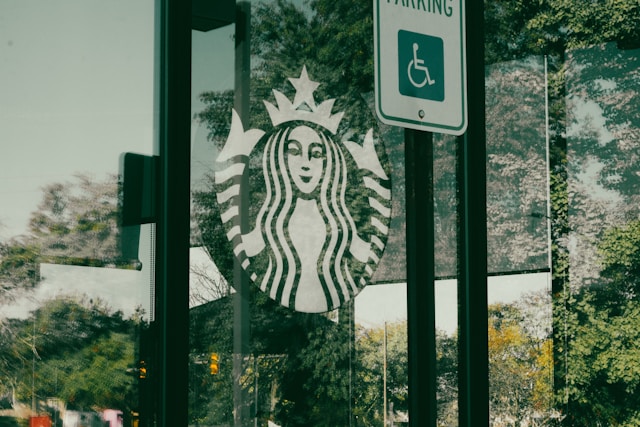In the bustling world of coffeehouses, where the aroma of freshly brewed coffee tantalizes the senses, one brand has managed to rise above the noise and capture the hearts of millions worldwide: Starbucks. This Seattle-born coffee giant has transformed from a single store in Pike Place Market to a global powerhouse with over 32,000 locations. For marketing professionals seeking to glean insights from successful brands, Starbucks’ marketing strategy offers a treasure trove of lessons. In this blog post, we will explore the multifaceted marketing strategies that have propelled Starbucks to the forefront of the coffee industry.

The Power of Brand Identity
At the core of Starbucks’ success lies a strong and consistent brand identity. From its iconic green mermaid logo to its distinctive store design and ambiance, every element of Starbucks exudes a sense of warmth, comfort, and sophistication. This cohesive brand image is meticulously maintained across all touchpoints, ensuring that customers feel a sense of familiarity and connection whether they are in New York, Tokyo, or Paris.
Starbucks’ branding is not just about visual elements; it is deeply rooted in the company’s mission and values. The brand positions itself as a third place, a welcoming environment that sits between home and work, where people can relax, socialize, or get some work done. This positioning is reinforced by the company’s commitment to quality, sustainability, and ethical sourcing. By aligning its brand with these values, Starbucks has cultivated a loyal customer base that shares its ethos.
Creating an Emotional Connection
One of the most powerful aspects of Starbucks’ marketing strategy is its ability to create an emotional connection with its customers. Starbucks doesn’t just sell coffee; it sells an experience. From the moment a customer steps into a Starbucks store, they are greeted with the aroma of freshly brewed coffee, the sound of baristas crafting beverages, and a cozy, inviting atmosphere. This sensory experience is designed to evoke positive emotions and create a sense of belonging.

Starbucks leverages storytelling to deepen this emotional connection. The company’s marketing campaigns often feature heartwarming stories about the origins of its coffee beans, the communities that grow them, and the baristas who bring them to life. By humanizing its brand and sharing these stories, Starbucks fosters a deeper connection with its customers, making them feel like they are part of something bigger.
Personalization at Scale
In today’s digital age, personalization is key to creating a memorable customer experience. Starbucks has embraced this trend by leveraging technology to deliver personalized marketing at scale. The Starbucks Rewards program is a prime example of this strategy in action. By analyzing customer data, Starbucks can tailor its marketing messages and offers to individual preferences, ensuring that each customer feels valued and understood.
The Starbucks mobile app is another powerful tool for personalization. The app not only allows customers to order and pay for their drinks ahead of time but also provides personalized recommendations based on past purchases. This level of customization enhances the customer experience, driving loyalty and increasing sales.
Innovative Product Offerings
Innovation is a cornerstone of Starbucks’ marketing strategy. The company continuously introduces new and exciting products to keep its menu fresh and appealing. From seasonal favorites like the Pumpkin Spice Latte to innovative beverages like the Nitro Cold Brew, Starbucks is always pushing the boundaries of what a coffeehouse can offer.

Starbucks’ product innovation extends beyond beverages. The company has expanded its food menu to include a wide range of items, from breakfast sandwiches to protein boxes, catering to the diverse tastes and dietary needs of its customers. This commitment to innovation ensures that there is always something new for customers to try, keeping them coming back for more.
Community Engagement and Social Responsibility
Starbucks has built its brand on a foundation of social responsibility and community engagement. The company is committed to ethical sourcing, environmental sustainability, and community involvement, and these values are woven into its marketing strategy.
Starbucks’ commitment to ethical sourcing is evident in its Coffee and Farmer Equity (C.A.F.E.) Practices, which ensure that coffee is sourced in a way that is economically, socially, and environmentally sustainable. This commitment not only supports coffee farmers but also resonates with socially conscious consumers who want to make ethical choices.
Environmental sustainability is another key focus for Starbucks. The company has set ambitious goals to reduce its environmental footprint, including initiatives to reduce waste, conserve water, and promote recycling. These efforts are highlighted in Starbucks’ marketing campaigns, reinforcing the brand’s commitment to sustainability.
Community engagement is also a crucial aspect of Starbucks’ marketing strategy. The company actively supports local communities through various initiatives, such as the Starbucks Foundation, which funds programs that promote education, youth leadership, and economic development. By giving back to the communities it serves, Starbucks strengthens its brand reputation and builds goodwill among its customers.
The Power of Social Media
In the digital age, social media is an indispensable tool for engaging with customers and building brand loyalty. Starbucks has harnessed the power of social media to connect with its customers on a deeper level. The company’s social media presence is vibrant, engaging, and interactive, allowing it to foster a sense of community and keep customers informed about new products and promotions.
Starbucks uses social media platforms like Instagram, Twitter, and Facebook to share visually appealing content, including mouthwatering photos of its beverages and behind-the-scenes glimpses of its stores and baristas. The company also encourages user-generated content by creating branded hashtags and running social media campaigns that invite customers to share their Starbucks experiences. This not only increases brand visibility but also fosters a sense of community among Starbucks fans.
Strategic Partnerships and Collaborations
Strategic partnerships and collaborations are another key element of Starbucks’ marketing strategy. The company has formed alliances with various brands and organizations to enhance its offerings and reach new audiences. For example, Starbucks has partnered with major retailers like Target to open in-store cafes, making it more convenient for customers to grab their favorite coffee while shopping.

Starbucks has also collaborated with technology companies to enhance its digital offerings. The partnership with Spotify, for instance, allows customers to discover and enjoy curated playlists while sipping their coffee. These collaborations not only add value to the customer experience but also help Starbucks stay relevant in a rapidly evolving market.
Expanding the Global Footprint
Starbucks’ global expansion strategy has been instrumental in its growth. The company has successfully entered new markets by adapting its offerings to local tastes and preferences while maintaining its core brand identity. This delicate balance of global consistency and local customization has allowed Starbucks to resonate with customers worldwide.
In new markets, Starbucks often introduces region-specific products and flavors that cater to local tastes. For example, in China, Starbucks offers beverages like the Red Bean Green Tea Frappuccino, which appeals to local palates. This localization strategy ensures that Starbucks remains relevant and appealing to customers in diverse markets.
Data-Driven Decision Making
In the era of big data, Starbucks has embraced data-driven decision making to optimize its marketing efforts. The company collects and analyzes vast amounts of data from its loyalty program, mobile app, and other sources to gain insights into customer behavior and preferences. This data-driven approach allows Starbucks to make informed decisions about product development, marketing campaigns, and store locations.
For instance, by analyzing purchasing patterns, Starbucks can identify trends and preferences, enabling it to introduce new products that are likely to be well-received by customers. This data-driven strategy not only enhances the customer experience but also drives sales and profitability.
The Role of Digital Transformation
Digital transformation has played a crucial role in Starbucks’ marketing strategy. The company has invested heavily in technology to enhance the customer experience and streamline its operations. The Starbucks mobile app, for example, has become a cornerstone of the company’s digital strategy, offering a seamless and convenient way for customers to order and pay for their drinks.
Starbucks has also embraced digital payment options, such as mobile wallets and contactless payments, to provide a frictionless checkout experience. This focus on digital innovation ensures that Starbucks stays ahead of the curve and meets the evolving needs of its customers.
A Blueprint for Success
Starbucks’ marketing strategy is a masterclass in creating a strong brand identity, fostering emotional connections, and leveraging technology to enhance the customer experience. By staying true to its values, embracing innovation, and engaging with its community, Starbucks has built a loyal customer base and achieved remarkable growth.
For marketing professionals seeking inspiration from successful brands, Starbucks offers valuable lessons in brand building, customer engagement, and strategic decision making. By studying and applying these principles, marketers can create compelling and memorable experiences that resonate with their customers and drive long-term success.
In the end, Starbucks’ success is not just about selling coffee; it’s about creating a brand that people love and a community that people want to be a part of. This is the magic of Starbucks, and it’s a blueprint for success that marketers can aspire to emulate.
Five Lessons Marketing Professionals Can Learn from Starbucks
Starbucks’ marketing strategy is a goldmine of insights for any marketing professional. Here are five key lessons that can be gleaned from the coffee giant’s success:
1. Consistency is Key
One of the hallmarks of Starbucks’ marketing strategy is its consistent brand identity. From the logo to the store ambiance, every detail is meticulously designed to create a unified and recognizable brand image. This consistency fosters trust and loyalty among customers, as they know what to expect no matter which Starbucks location they visit. Marketing professionals should strive to maintain consistency across all brand touchpoints, ensuring that every interaction with the brand reinforces its core values and identity.
2. Personalization Enhances Customer Loyalty
Starbucks excels in leveraging technology to deliver personalized experiences at scale. The Starbucks Rewards program and mobile app are prime examples of how personalized marketing can drive customer loyalty. By analyzing customer data, Starbucks tailors its marketing messages and offers to individual preferences, making each customer feel valued and understood. Marketing professionals should invest in tools and technologies that enable them to gather and analyze customer data, allowing them to create personalized marketing campaigns that resonate with their audience.
3. Innovation Keeps the Brand Fresh
Innovation is a cornerstone of Starbucks’ success. The company constantly introduces new products and services, keeping its offerings fresh and exciting. This not only attracts new customers but also keeps existing customers engaged and coming back for more. Marketing professionals should foster a culture of innovation within their organizations, encouraging the development of new ideas and products that can differentiate their brand in the market.
4. Storytelling Creates Emotional Connections
Starbucks’ ability to create emotional connections with its customers is a key factor in its success. Through compelling storytelling, the company humanizes its brand and builds a sense of community. Stories about the origins of its coffee beans, the farmers who grow them, and the baristas who craft the beverages make the brand relatable and engaging. Marketing professionals should harness the power of storytelling to create emotional connections with their audience, sharing authentic and relatable stories that resonate with their customers.
5. Commitment to Social Responsibility Builds Brand Equity
Starbucks’ commitment to social responsibility and sustainability is deeply embedded in its brand identity. By aligning its marketing efforts with its values, Starbucks not only attracts socially conscious consumers but also builds long-term brand equity. Marketing professionals should ensure that their brand’s values and social responsibility initiatives are not just an afterthought but an integral part of their marketing strategy. This alignment can enhance the brand’s reputation, foster customer loyalty, and drive long-term success.

